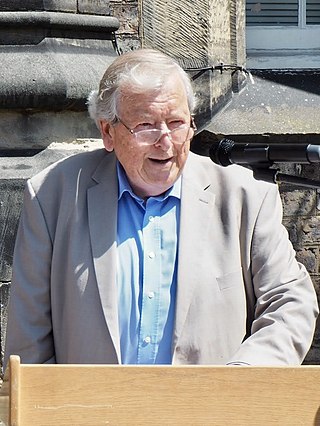Related Research Articles
The year 1981 in archaeology involved some significant events.
Below are notable events in archaeology that occurred in 1915.
The year 1971 in archaeology involved some significant events.
Below are notable events in archaeology that occurred in 1904.
The year 1991 in archaeology involved some significant events.
Below are notable events in archaeology that occurred in 1928.
Below are notable events in archaeology that occurred in 1929.

Pueblo Bonito is the largest and best-known great house in Chaco Culture National Historical Park, northern New Mexico. It was built by the Ancestral Puebloans who occupied the structure between AD 828 and 1126.

Chetro Ketl is an Ancestral Puebloan great house and archeological site located in Chaco Culture National Historical Park, New Mexico, United States. Construction on Chetro Ketl began c. 990 and was largely complete by 1075, with significant remodeling occurring in the early and mid-1110s. Following the onset of a severe drought, most Chacoans emigrated from the canyon by 1140; by 1250 Chetro Ketl's last inhabitants had vacated the structure.

Dr Margaret Helen Rule, was a British archaeologist. She is most notable for her involvement with the project that excavated and raised the Tudor warship Mary Rose in 1982.
The year 2007 in archaeology

Bronze Age Britain is an era of British history that spanned from c. 2500–2000 BC until c. 800 BC. Lasting for approximately 1,700 years, it was preceded by the era of Neolithic Britain and was in turn followed by the period of Iron Age Britain. Being categorised as the Bronze Age, it was marked by the use of copper and then bronze by the prehistoric Britons, who used such metals to fashion tools. Great Britain in the Bronze Age also saw the widespread adoption of agriculture.

Pei Wenzhong, or W. C. Pei, was a Chinese paleontologist, archaeologist and anthropologist born in Fengnan. He is considered a founding figure of Chinese anthropology.

Michael Joseph "Brian" O'Kelly was an Irish archaeologist who led the excavation and restoration of Newgrange, a major Neolithic passage tomb in the Boyne Valley, County Meath, Ireland, now a UNESCO World Heritage Site.
The Society for Underwater Historical Research (SUHR) was an amateur maritime archaeology organisation operating in South Australia (SA). It was formed in 1974 by recreational scuba divers and other persons to pursue an interest in maritime archaeology and maritime history. The SUHR was renamed as the South Australian Archaeology Society in March 2012 as part of a plan to expand its activities beyond maritime archaeology to include other archaeological disciplines.

Prehistoric art in Scotland is visual art created or found within the modern borders of Scotland, before the departure of the Romans from southern and central Britain in the early fifth century CE, which is usually seen as the beginning of the early historic or Medieval era. There is no clear definition of prehistoric art among scholars and objects that may involve creativity often lack a context that would allow them to be understood.

Peter Vincent Addyman,, known as P. V. Addyman, is a British archaeologist, who was Director of the York Archaeological Trust from 1972 to 2002. Addyman obtained a degree in archaeology at Cambridge University, after which he lectured at Queen's University Belfast and the University of Southampton, while also conducting excavations. In 1972 he was offered the directorship of the newly founded York Archaeological Trust, the creation of which he had proposed; along with excavation work in York, he oversaw the development of the Jorvik Viking Centre, the Archaeological Resource Centre, and Barley Hall. In 2000 he was appointed a Commander of the Order of the British Empire.
Dominic Tweddle,, is an English archaeologist specialising in Anglo-Saxon studies and the director general of the National Museum of the Royal Navy. Previously he spent time as a research assistant at the British Museum and as the assistant director of the York Archaeological Trust, where he helped develop the Jorvik Viking Centre. He is also an honorary professor at the UCL Institute of Archaeology and the University of Portsmouth.

The Guilden Morden boar is a sixth- or seventh-century Anglo-Saxon copper alloy figure of a boar that may have once served as the crest of a helmet. It was found around 1864 or 1865 in a grave in Guilden Morden, a village in the eastern English county of Cambridgeshire. There the boar attended a skeleton with other objects, including a small earthenware bead with an incised pattern, although the boar is all that now remains. Herbert George Fordham, whose father originally discovered the boar, donated it to the British Museum in 1904; as of 2018 it was on view in room 41.
References
- ↑ "Mary Rose rises after 437 years". On This Day. BBC. 11 October 1982. Retrieved 15 May 2017.
- ↑ Elkin, Dolores (2022). "Archaeological research and heritage management of a British shipwreck in Argentina - the legacy of HMS Swift (1770)". Post-Medieval Archaeology. 56: 225–48. doi:10.1080/00794236.2022.2120718 . Retrieved 2024-01-17.
- ↑ "The York Helmet". York: Yorkshire Museum . Retrieved 15 May 2017.
- ↑ Trombold, Charles D. (1991). Ancient Road Networks and Settlement Hierarchies in the New World. Cambridge University Press. p. 7. ISBN 9780521383370.
- ↑ "Pei, Wenzhong (1904-1982) - People and organisations". Trove. Retrieved 15 May 2017.
- ↑ O'Kelly, Michael J.; O'Kelly, Claire (6 April 1989). Early Ireland: An Introduction to Irish Prehistory. Cambridge University Press. p. xi. ISBN 9780521336871.